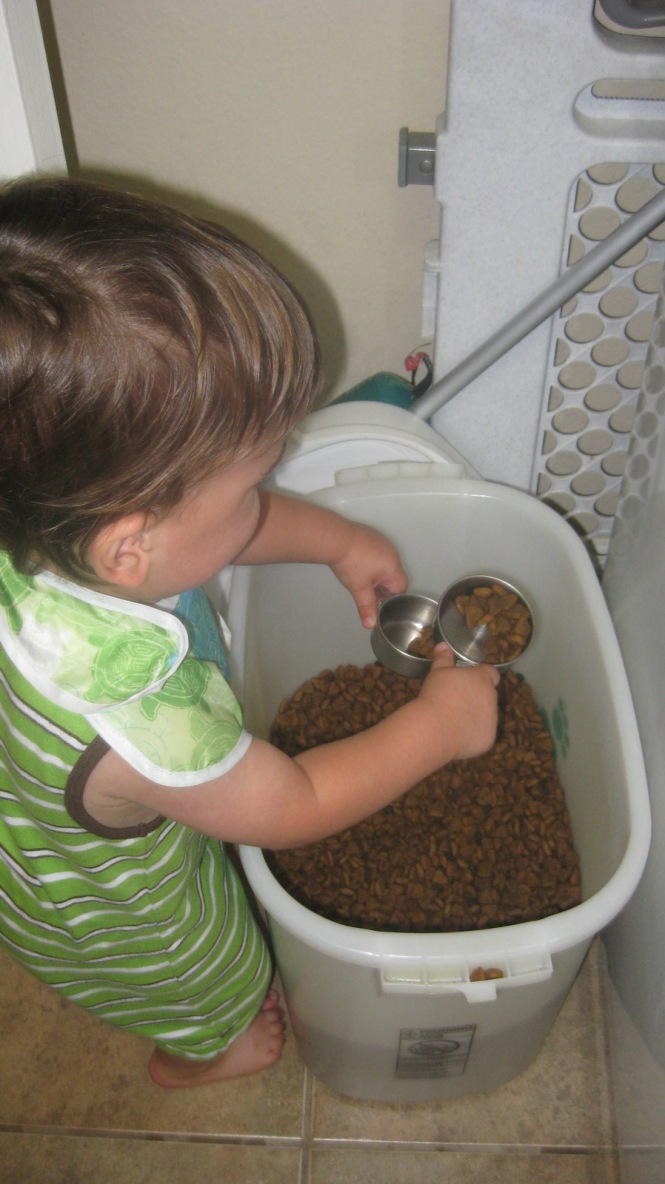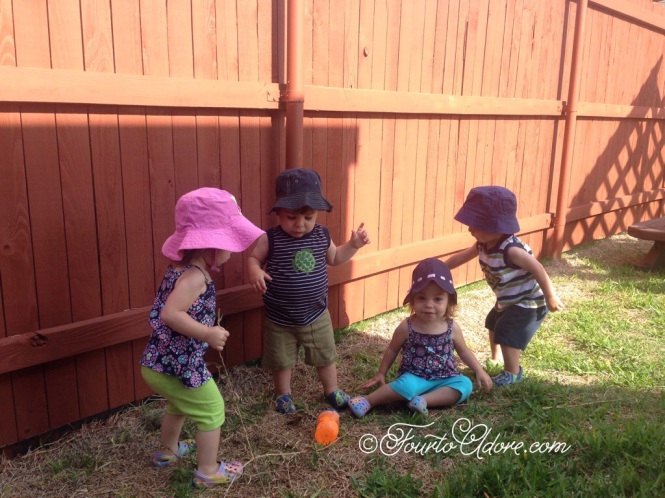I practice school psychology, and have for nearly a decade now. Even before I began my graduate program, I worked as both a nanny and daycare teacher. And that’s not to mention the fact that both of my parents were teachers. Based upon those experiences, I have all the knowledge and skills to mold my children into well-behaved little people. Except, I don’t always use the tools sitting in my toolbox. In the heat of the moment, when four toddlers are shrieking at the top of their lungs and I’m covered in food splatter, my skill set tends to go out the window. I’m not implying that my training hasn’t gone to good use or that I never use my toolkit. Rather, I’m admitting that I am indeed a human being and just like every other parent, teacher, and caregiver, I lose my cool sometimes. I don’t always make good use of the skills I possess because sometimes I forget.
As the quads are getting older, more independent, and smarter, it’s clear that it’s critical that I work harder on doing the exact things I recommend others do. Of course, it’s always significantly easier to give suggestions to others than yourself isn’t it? Nonetheless, I’m making an effort to take my own good advice and use it on my own children.
Years ago, I was trained in Teaching with Love and Logic: Taking Control of the Classroom. It’s a program that I frequently recommend to parents and teachers. When one of my colleagues informed me that there was a toddler version, Love and Logic Magic for Early Childhood, I found it on Amazon and placed the order. As I read the book, it brought all of my training to the forefront with toddlers in mind. If you have a toddler, or toddlers, I highly recommend snagging a copy for yourself to see if you can adopt some of the concepts within it.
When I consult with parents and teachers, I find myself offering many of the same recommendations time and time again. It’s not because I’m lazy. Instead, it’s because I’ve seen particular strategies work time and time again for many different types of kids. During my days with the quads, I’ve been taking time to pause and consider what I might tell a teacher or parent in my position. The same tried and true school interventions work at home, and I’m seeing positive results. Some of my go-to suggestions include:
1. Set clear, consistent boundaries, and follow through with all consequences immediately.
After we moved into the new house, I seized the perfect opportunity to establish new house rules in order to break some bad habits. In addition to the rules, we are teaching the quads to be responsible for their actions. For instance, they often think it’s a lot of fun to toss food and utensils during mealtime. If someone drops something from the table, we say, “Ooops, all done”. Then, after everyone is finished with the meal, the offender picks up anything thrown and wipes up spills. In a nutshell, the rules are something to the effect of “If you make a mess, clean it up. If you break something, fix it. If you hurt someone, apologize…ect.”

The quads are well aware that they must sit in order to enjoy a drink. When they request a drink they now say “sit down” as they comply with our house rule.
It’s important that consequences occur immediately after an offense otherwise, they think they can get away with rule breaking anytime. I know we are making headway in this arena because when a rule is broken, I sometimes hear the renegade say, “Uh oh! Time out?” or another child will say, “Uh oh!”

It’s not unusual for our kitchen floor to look like this during or after a meal. However, I’m done cleaning up everyone’s messes.

Time out is among the consquences in our house. When I first introduced time out, I set the offender in my lap as I held their arms across their chest and counted aloud. We have since progressed to nose to the wall or corner.
2. Provide sensory motor breaks throughout the day, especially between transitions.
With toddlerhood, our schedule is much more flexible than it once was. However, we still maintain quite a bit of structure in the day, which helps make things predictable and comfortable for everyone. Of the quads, Harper tends to have more energy to burn. With him, I make a point to integrate physical activity into our day, several times. Often times, he has days where he pushes the others or runs around destructively. When I notice that type of behavior, I know it’s time to either go outside, or to use some of our gross motor toys (e.g. mini trampoline, slide, riding toys).
3. Allow the child to participate in “helper” activities aka chores.
Everyone likes to feel important and valued, toddlers are no different. As the quads receptive language skills have improved, they’ve been very capable of carrying out simple 1-2 step directions. With supervision, they clean up their playroom, put laundry in the hamper, throw trash away, and feed the dogs. I find that they do best when I am very specific about what needs to be done. For example, I may say, “Please put the blue plate in this basket”. If a verbal direction doesn’t work, I sometimes model what I’m asking for, or help them complete the task hand over hand. After they’ve helped complete some task, I offer ample praise, and they always beam in delight.
4. Provide TONS of praise, which is specific to the behavior. (Praise should ideally occur four times more than redirection. So, if you reprimand a child, he’ll need to be praised for about four appropriate behaviors).
When the quads have done something I like, it’s important to know exactly what they did right so they do it again. For example, they are trying really hard to use their manners so if I hear someone saying “please” or “thank you”, I try to jump in immediately and tell them how well they are doing with using manners. I may say, “Wow, Mason! Great job saying thank you!” or “Oh Sydney, I love how you said please.”
5. Phrase redirection and rules in positive terms (e.g. Say, “Our feet go on the floor” instead of “No standing on chairs”.
Little kids often hear the last thing you said so if it’s in negative terms, they may misunderstand you. You don’t want a toddler thinking you told him to “Stand on the chair”! Again, with little ones or kids with developmental or language delays a verbal message can be lost. Sometimes modeling or showing pictures of what the rule is can help.
6. Empathize with an upset child and allow cool down time.
The quads are toddlers and they have tantrums A LOT. Toddler tantrums are never pretty, and they are exacerbated with multiples. Even though toddlers are not generally rational, they have feelings too. If someone is upset I try to tell them I am sorry they are feeling angry/ mad/ upset. This doesn’t mean I try to rescue them or coddle them. Most of the time, tantrums occur because they were denied their way. Giving them what they wanted (e.g. a cookie, a particular toy) to stop a tantrum will make it significantly worse. Giving in would be counterproductive because it would teach them to have tantrums to get what they want.
When someone is having a very difficult time, I offer them cool down time by taking them to a quiet place and encouraging them to take slow deep breaths. If me facilitating cool down time is unsuccessful, I typically leave them alone for a minute or two, allowing them to calm down independently. I find that placing them in their crib with a preferred toy or book can help them regain composure.
Cool down time is different than time out in that it’s not punitive, rather it allows everyone time to become calm. Sometimes cool down time is needed before a consequence can be implemented. Take the example of making a mess at the table. Sometimes being asked to clean up spurs a tantrum. I may allow time to cool down before I expect a clean up effort to occur.
7. Provide 2-3 acceptable choices.
Everyone likes to feel as if they have control and power. However, it’s not wise to let toddlers and children rule a home. Instead, it’s better to give them parameters for decision making. This can actually be very simple. For instance, at meal times, I let the quads chose between two bibs to wear and two colored plates. A choice can also be between having something or not such as “Do you want to wear socks or no socks.” This empowers little ones and helps prevent future meltdowns.
I also offer choices in the heat of a tantrum as a means to help redirect them. Let’s say Rylin had a tantrum because she wanted strawberries instead of blueberries and we have no strawberries. I may say, “Would you like blueberries or no berries?” This type of choice can help refocus her attention from the strawberries we don’t have.
8. Use first/ then statements.
Kids often want instant gratification and become upset when something doesn’t happen immediately. With the quads, I often use first then statements to let them know the order things will happen. For example, if someone approaches me and says, “Read it” while I’m busy. I may reply, “First, I’m washing dishes then I’ll read it”. It also works to get them to comply with something undesirable. For instance, the quads resist diaper changes because they want to do something else. My response is usually something like, “First I’m going to change your diaper, then you can do your puzzle.”
Even though I’m making an effort to utilize these particular tools as well as my training and experiences, I won’t get it right every single time. There will be times I will make a mistake with the quads, and that’s okay. In those moments, it’ll be important for me to apologize to my children and explain to them that Mommy is a human too. After all, grace is a virtue I want my children to learn too.
hugs,
Amber
Note: This post is in no way sponsored by Love and Logic, but it is a parenting book I feel is beneficial and wholeheartedly recommend. Also, my tips are not a summary of Love and Logic. Instead they are based upon my professional training, continuing education, and experiences, which include Love and Logic training.
This post may contain affiliate links. For more info, please see my disclaimer page.







